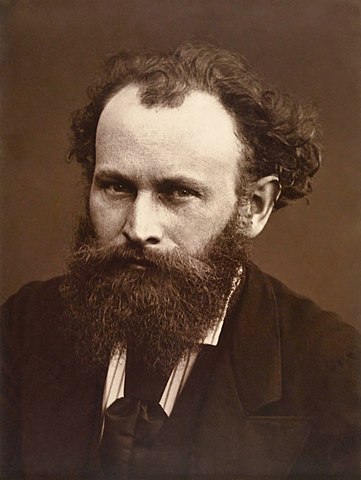
Born: 23 January 1832, Paris
Died: 30 April 1883 (aged 51)
Period: Realism, Impresionism
The Life of Édouard Manet
Édouard Manet was a pivotal figure in the transition from Realism to Impressionism and is often regarded as one of the 19th century’s most innovative and influential artists. Born into an affluent and well-connected family in Paris, Manet was encouraged to pursue law by his father but was drawn to art from an early age. He defied his father’s wishes and instead began studying art under the academic painter Thomas Couture. During his early career, Manet traveled extensively in Europe, where he was influenced by the works of the Old Masters, as well as by Spanish, Dutch, and Italian art.
Manet’s early works adhered to the traditional themes and techniques of his time but soon evolved to challenge the conventions of academic painting. He developed a style characterized by bold brushstrokes, simplified details, and the use of light and shadow, which departed from the detailed and polished finish that was favored by the Paris Salon. Manet’s subjects ranged from contemporary life to portraits and nudes, often stirring controversy for their unorthodox styles and themes.
His painting “Le Déjeuner sur l’herbe” (Luncheon on the Grass), exhibited in 1863, was met with scandal and outrage for its depiction of a nude woman casually lunching with two fully dressed men. Another of his works, “Olympia” (1865), provoked a similar reaction for its portrayal of a nude prostitute, challenging traditional representations of the female nude in art. Despite the controversies, these paintings are now celebrated for their modern approach and for laying the groundwork for Impressionism.
Manet was a central figure in the Parisian art world, and his studio became a meeting place for the younger generation of artists who would become the Impressionists. Although Manet never considered himself part of the Impressionist movement and continued to seek recognition from the official Salon, his techniques and approach to subject matter greatly influenced Impressionist painters.
Throughout his career, Manet struggled with health issues and was affected by the political turmoil and societal changes of his time. Despite these challenges, he continued to paint and exhibit his work. In his later years, he received some official recognition, including a medal at the Paris Salon in 1881.
Édouard Manet passed away in Paris in 1883, leaving behind a legacy that bridged the gap between realism and impressionism. His work marked a departure from traditional academic art and opened the door for the exploration of modern life and the innovative use of paint that would define the Impressionist movement. Manet’s bold experimentation with painting techniques and his defiance of conventional subject matter have secured his place as a foundational figure in modern art.
Édouard Manet’s Notable Works
Édouard Manet, a key figure in the transition from Realism to Impressionism, left an indelible mark on the art world with his innovative approach to painting and subject matter. Here are ten of Manet’s most famous works, each illustrating his groundbreaking techniques and the controversies and acclaim they garnered:
- Olympia (1863) – This painting, depicting a nude woman lying on a bed while being attended by a servant, caused a scandal for its frank portrayal of a prostitute. Its confrontational gaze and flatness of form challenged traditional depictions of the nude.
- Le Déjeuner sur l’herbe (Luncheon on the Grass) (1863) – Another of Manet’s controversial works, it features two fully dressed men picnicking with a nude woman, breaking traditional representation conventions and leading to widespread public outcry for its perceived indecency.
- A Bar at the Folies-Bergère (1882) – Manet’s last major work, this painting is celebrated for its complex use of perspective and reflection, offering a nuanced and detached observation of Parisian life.
- The Railway (1873) – This painting is a vivid depiction of modern life, showing a woman and a child by the rail tracks at the Gare Saint-Lazare, Paris. Its contemporary subject matter and loose brushwork signify Manet’s move towards Impressionism.
- The Balcony (1868-69) – Influenced by Spanish art, this painting shows people standing on a balcony, but rather than interacting, they appear disconnected, highlighting Manet’s interest in capturing the peculiarities of modern life.
- Music in the Tuileries Gardens (1862) – This early work, depicting a fashionable crowd at a music concert in Paris, illustrates Manet’s fascination with the leisure activities of Parisian society and his circle of friends, including writers, artists, and musicians.
- The Execution of Emperor Maximilian (1867) – A politically charged work, it depicts the execution of the Austrian archduke Maximilian, installed as Emperor of Mexico by Napoleon III. The painting was a bold critique of French foreign policy and demonstrated Manet’s engagement with contemporary events.
- Berthe Morisot with a Bouquet of Violets (1872) – This portrait of the Impressionist painter Berthe Morisot, who was also Manet’s sister-in-law, is noted for its intimate and informal quality, showcasing Manet’s skill in portraiture.
- The Fifer (1866) – A simple yet striking portrayal of a young boy in the uniform of the French Imperial Guard, playing a fife. The flatness and starkness of the composition are typical of Manet’s departure from academic norms.
- Boating (1874) – This work is indicative of Manet’s interest in leisure and depicts a man rowing a boat, capturing the light and movement of the water with quick, loose brushstrokes that hint at the Impressionist style.
These works collectively showcase Manet’s radical approach to painting, his mastery of light and composition, and his profound influence on the development of modern art, setting the stage for the Impressionist movement and altering the course of art history.